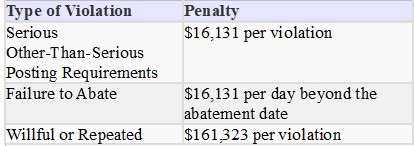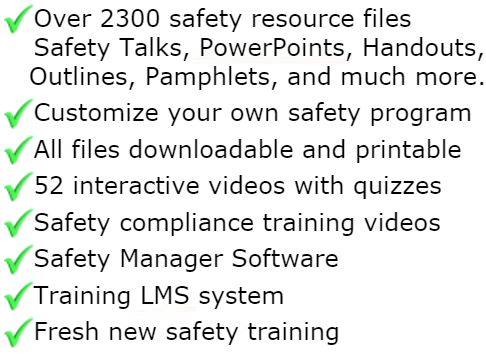
Safety Signs & Safety Label Requirements
This is a sample or partial document
Download the full customizable and printable version
ANSI Z535 and the OSHA §1910.14 Specifications for Accident Prevention Safety Signs require the use of safety signs to indicate specific hazards that, without identification, may lead to accidental injury to workers and/or the public, or lead to property damage. Keep signs simple and concise, but also make sure they communicate sufficient information so that the message is clear.
OSHA compliant safety labels should be designed to the same standards as safety signs. For example, they should use the same colors as signs. Be consistent in your design so that your labels look like your signs. Variations in design can result in confusion and result in more time needed to read and understand the label. Consistent design of labels and signs, the colors used, how safety symbols are used, and what the header looks like all help communicate critical information quickly.
Types & Meanings
Danger signs indicate an immediate hazard which, if not avoided, will result in death or serious injury. Danger signs should be limited to the most extreme situations and signify that special precautions are necessary.
The heading “DANGER” is printed in white letters on a red background and is preceded by the safety alert symbol (an equilateral triangle surrounding an exclamation mark). The message should be printed in black or red letters on a white background, or white letters on a black background. Additional safety symbols may be included in the message area.
Warning signs represent a hazard level between caution and danger. “Warning” indicates a hazardous situation which, if not avoided, could result in death or serious injury.
The heading “WARNING” (preceded by the safety alert symbol) is written in black on an orange background. Additional wording and safety symbols are printed in black on the lower portion of the sign. Warning signs and labels can be any size, but it is appropriate for the sign to be noticed and easily read from a safe distance. They need to communicate the warning information before someone is in a dangerous area or acts in a dangerous manner.
Caution sign indicates a potentially hazardous situation which, if not avoided, may result in minor or moderate injury. Caution signs are used in areas where potential injury or equipment damage is possible, or to caution against unsafe practices. Caution signs should only be used if there is a risk of personal injury. The heading “CAUTION” is written in black letters on a yellow background and is preceded by the safety alert symbol. The message and safety symbols in the body of the sign are printed in black.
Biological Hazard signs. According to OSHA §1910.145(e)(4), “The biological hazard warning shall be used to signify the actual or potential presence of a biohazard and to identify equipment, containers, rooms, materials, experimental animals, or combinations thereof, which contain, or are contaminated with, viable hazardous agents… presenting a risk or potential risk to the well-being of man.” The symbol design must conform to the design as shown in the “BIOHAZARD” sign and contain the word “Biohazard” or “Biological Hazard.” The biohazard symbol can be black, fluorescent orange, or orange-red color. Background color is optional as long as there is sufficient contrast for the biohazard symbol to be clearly defined. A biohazard can also be indicated on a danger or warning sign and may include the safety alert symbol.
Notice signs provide general information that is important or relevant to a building, an area, a machine, or equipment. Notice signs address practices not related to personal injury. The heading “NOTICE” should be in white italic letters on a blue background. Notice signs should never include the safety alert symbol. The body of the sign is white, and the message is in blue or black lettering on a white background, or white lettering on a black background. Safety symbols can be printed in either blue or black. Notice signs can include information about procedures, operating instructions, maintenance information, rules, or directions. Notice signs are never used for personal injury hazards or warnings, but can be used to indicate possible equipment or property damage.
General Safety signs are used to provide notices of general practice and rules relating to health, first aid, medical equipment, sanitation, housekeeping, and suggestions relative to general safety measures.
Signs containing safety instructions or procedures should use heading “SAFETY INSTRUCTIONS” or “SAFETY PROCEDURES.” Where practical, use a more definitive heading, such as “SAFETY SHUTDOWN PROCEDURE.” Signs indicating the location of safety equipment should use a specific header such as “EYEWASH.” If multiple safety items are in the same location, simply use the header “SAFETY EQUIPMENT.”
The message and safety symbols should be printed in green or black on a white background. The signs may also be printed in white on a green background. These signs should never include the safety alert symbol.
Fire Safety signs are used to indicate the location of emergency fire fighting equipment. Unlike other signs, they do not require a header. The message and safety symbol are printed in red on a white background, or in white on a red background. Because these signs do not indicate a personal safety hazard, the safety alert symbol must not be used. Fire safety signs are not used to show the direction to fire equipment, but rather its immediate location
Admittance signs bridges all of the above categories. Admittance messages may be included on a sign with any header. You might decide to put “Unauthorized Personnel, Keep Out” on a danger, warning, caution, or notice sign. You may choose to include an admittance message on a general safety sign. The type of header and message content should be determined by the personal risk (if any) or consequences of entering the restricted area. The primary action statement should be simple, direct, and applicable to the hazard. Keep only essential hazard-related information on the sign. If necessary, consideration can be given to referring the viewer to another source for additional safety information or for permission to proceed. When information on consequence, avoidance, or type of hazard is readily inferred, this information may be omitted from the message panel.
Safety Symbols - Signs and labels may include safety symbols, often called pictograms pictorials, or glyphs. Safety symbols can portray required actions, consequences, explicit direction, or the effects of interaction with certain chemicals, machines, and other hazards. Signs and labels may include more than one pictorial to show a sequence of events for one hazard. Safety symbols should be consistent, readable, and easily understood. They usually consist of a black image on a white background.
Surround Shapes - You may consider using a surround shape. However, a surround shape will decrease the available space for a symbol. Surround shapes should not be used if they detract from the major message.
HAZARD ALERTING - You can use this surround shape to highlight a hazardous condition. The symbol should be drawn within a black equilateral triangle and can include a yellow background.
MANDATORY ACTION - This type of symbol conveys actions that must be taken to avoid hazards. This symbol consists of a white image within a solid blue or black circle.
PROHIBITION - For actions that should not be taken, this surround shape is required. It consists of a red or black circle with a diagonal slash at 45° from the upper-left to the lower-right.
INFORMATION - The square (or rectangular) surround shape is typically used to convey equipment location, places of exit, and permitted actions.
Safety Symbols
When appropriate, you may use a graphic representation that conveys your message without using words. The safety symbol should “describe the type of hazard, or evasive/avoidance actions to be taken” ANSI Z535.2-2007 (8.1.2). Safety symbols should effectively communicate the message, be easily understood, and be visible from a safe distance.
Message Panel - The message panel describes a hazard, indicates how to avoid it, and advises workers of the consequences of not avoiding the hazard. Always follow these basic guidelines:
• Use left-aligned text
• Use sentence-style capitalization
• Use sans-serif fonts (such as Helvetica)
• Avoid prepositional phrases
• Write in “headline style”
• Use active voice
When determining the order of the message content, consider the target audience’s prior knowledge of the hazard and the necessary reaction time required to avoid dangerous consequences. Also, make sure that the most urgent message is the most prominent. OSHA 1910.145(e)(2) states: “The wording of any sign should be easily read and concise. The sign should contain sufficient information to be easily understood. The wording should make a positive, rather than negative suggestion and should be accurate in fact.”
Employee Training
Employers are required to conduct training to ensure workers understand the various types and meanings of signs in their facilities. The best time to train is during new hire safety orientation and during annual safety refreshers. Showing and explaining safety signs and their meanings in company newsletter and on employee bulletin boards will also help improve employees’ awareness of hazard signs. Effective employee training includes showing every type of sign, tag and label used. You should also provide an explanation of each purpose, meaning and what you expect employees to do when they encounter specific signs, labels or tags. Take special care to fully show and explain your hazard communication - chemical safety labeling program, which is also required by OSHA.
Sign Placement
Place hazard signs as close to the hazard as possible to create a definite link between the message and the hazard. Placing a group of hazard signs on a door, entryway or wall is asking for confusion. Let’s take a look at a typical plant maintenance shop. Every bench mounted tool should have hazard signs posted that require the use of eye protection and any other operation hazard that is applicable to the specific tool. These signs should be placed so that they are highly visible to the tool operator.
How you treat your signs sends a message
Over time signs become faded, damaged and totally useless for the intended hazard message. Outdated, faded or damaged signs send a negative message about your emphasis on safety. To show employees that the hazard sign messages are important, replace them (the signs not the employees) as soon as they have any wear or damage. Have replacement signs available - stock enough replacement signs so there is no wait when a sign needs to be replaced.
Sign Language Barrier
Being able to employ a diverse language workforce is essential in some industries. Using pictogram type safety signs to convey a hazard message can break reading or language barriers. To ensure that non-English speaking employees understand, some companies are employing translators to accompany trainers on facility tours with new employees to explain specific signs and their meanings. The food industry, which employees many non-English speaking Hispanic workers has seen the importance of bilingual signs. While bilingual signs are helpful, experience has shown that, as an example, not all "Hispanic" peoples speak or read the Spanish language the same - many words have entirely different meanings to various groups of peoples classified as "Hispanic". The same is true for many other ethnic groups.
Temporary Signs
Certain operations may require the use of temporary visual warning. One of the most familiar is the "wet floor" sign placed by custodians. Others include those placed at boundaries of electrical work areas, confined space entry operations, temporary containment for asbestos removal or chemical spill cleanup. OSHA also requires that if work exposes energized or moving parts that are normally protected, danger signs must be displayed and barricades erected, to warn other people in the area..
Information Signs
Beyond the typical "Notice" signs, there is sometimes the need for more detailed information signs that provide complex instructions. Generally, these are in the form of Posted Operating Instructions for equipment or processes that require specific step-by-step procedures to ensure safe operation. Plastic laminated paper instruction can be used in areas that are clean and dry, however, photoengraved metal signs will last longer, especially in areas that have wet or dirty operations.
Chemical Hazards
In the workplace, OSHA’s Hazard Communication Standard requires that each container of hazardous chemicals is labeled, tagged or marked. The identity of the hazardous chemical and appropriate hazard warnings, words, pictures, symbols must provide at least general information regarding the hazards of the chemical. Signs, placards, process sheets, batch tickets, operating procedures, or other written materials may be substituted for labels on individual stationary process containers, as long as this method identifies the containers to which it is applies and provides the same information required on labels. Small, portable containers, intended only for the immediate use of an employee and not for storage, do not require labels. Existing labels on containers, provided by the manufacturer, may not be removed or defaced unless the container is immediately marked with the required information.
Employee protection in public work areas
Before work is begun in the vicinity of vehicular or pedestrian traffic which may endanger employees, warning signs and/or flags or other traffic control devices must be placed conspicuously to alert and channel approaching traffic. At night, warning lights must be prominently displayed.
Aisles And Passageways
Permanent aisles and passageways have to be appropriately marked.
Welding & Brazing
All filler metals and fusible granular materials must show the following notice on tags, boxes, or other containers:
CAUTION
Welding may produce fumes and gases hazardous to health. Avoid breathing these fumes and gases. Use adequate ventilation. See ANSI Z49.1-1967 Safety in Welding and Cutting published by the American Welding Society.
Brazing (welding) filler metals containing cadmium in significant amounts must have the following notice on tags, boxes, or other containers.
WARNING
CONTAINS CADMIUM — POISONOUS
FUMES MAY BE FORMED ON HEATING
Do not breathe fumes. Use only with adequate ventilation such as fume collectors, exhaust ventilators, or air-supplied respirators. See ANSI Z49.1-1967. If chest pain, cough, or fever develops after use, call physician immediately.
Brazing and gas welding fluxes containing fluorine compounds shall have a cautionary wording to indicate that they contain fluorine compounds. One cautionary wording recommended by the American Welding Society for brazing and gas welding fluxes reads as follows:
CAUTION
CONTAINS FLUORIDES
This flux when heated gives off fumes that may irritate eyes, nose, and throat.
Avoid fumes — use only in well-ventilated spaces.
Avoid contact of flux with eyes or skin
Do not take internally
Permit-Required Confined Spaces
Exposed employees must be informed of the existence and location of and the danger posed by permit-required confined spaces through the posting of signs or by any other equally effective means. A sign reading "DANGER—PERMIT-REQUIRED CONFINED SPACE, DO NOT ENTER" or using other similar language would satisfy the requirement for a sign.
Lockout/Tagout
Tagout devices must warn against hazardous conditions if the machine or equipment is energized and shall include a legend such as the following: Do Not Start, Do Not Open, Do Not Close, Do Not Energize, Do Not Operate.
Fixed Extinguishing Systems
Hazard warning or caution signs must be posted at the entrance to, and inside of, areas protected by fixed extinguishing systems which use agents in concentrations known to be hazardous to employee safety and health.
Ladders
Ladders that have developed defects have to be taken out of service for repair or destruction. They must be tagged or marked as follows:
DANGEROUS, DO NOT USE
Flammable Liquids
Storage cabinets where flammable and combustible liquids are stored must be conspicuously labeled, "FLAMMABLE—KEEP FIRE AWAY."
No Smoking Signs
Near all Explosive Storage Areas
All spraying areas and paint storage rooms
Powder coating areas and powder storage rooms
Areas where organic peroxides are stored, mixed, or applied.
Drying, Curing, Or Fusion Apparatus
Near Dip Tanks Containing Flammable or Combustible Liquids
Near Bulk Flammable Storage Areas
Emergency Respirators
The employer must ensure that respirators are stored in compartments or in covers that are clearly marked as containing emergency respirators.
Other Required Signs
Other hazard signs and labels are required by OSHA and DOT for special industries, uses of industrial gases and equipment hazards.
Signs, Tags & Labels
Confined spaces
Exits & exit ways
Flammable storage
High noise
Respirator required
Eye hazard
Biohazard
Emergency stop
Low overhead
Empty gas cylinder
Restricted access
Hardhat required
Hot surfaces
Voltage ratings
High voltage
Pipe flow direction
Contents of piped systems
Automatic equipment
Removable machine guards
Chemical storage
Sprinkler controls
Forklift traffic
Machine hazards
No Smoking
Out of Service
Lockout points
Chemical information
MSDS location
Emergency exit map
More information on safety signs & labels can be found in the members area

GET INSTANT ACCESS
to THE MEMBERS LIBRARY
Safety materials created by safety professionals.
Access to the Safety Manager software.
Wide variety of safety videos and courses.
**Brand New** Safety Training Management System
Pre-Made Safety Materials Ready For Use
Created by experienced safety professionals & risk consultants. Saving you time, money, and risk of injuries.
95% of the work already done.
Below are the maximum penalty amounts, with the annual adjustment for inflation, that may be assessed after Jan. 15, 2024. (See OSHA Memo, Jan. 8, 2024).

**New OSHA HEAT 90 DAY**
>>Download Free HERE<<
**New 2024 OSHA 300 Form**
>>Download Free HERE<<
**Brand New**
Free with full membership subscription
Training LMS System
Ask The Safety Consultant
Safety Equipment Deal Finder

“SafetyInfo.com is the first go-to website for safety professionals and companies to use in establishing a solid safety program"
-Mike McKenzie, Certified Safety & Health Manager (CSHM), McSafety Solutions™
Note: You must have a full subscription to the Safety Library in order to use this material. Any use outside of your organization, for resell, or without an active membership is strictly prohibited and may result in prosecution under copyright infringement laws. Please contact us first, if you would be interested in reselling or using our materials for reproduction.
Inside the Members Library
Topic Index
Accident Prevention
Air Quality
Asbestos
Bloodborne Pathogens
Boilers
Chemical Safety
Compressed Gas
Confined Space
Construction
Construction Worksite
Cranes & Slings
Driver / Fleet Safety
Drug Free Workplace
Electrical
Emergency Management
Engineering Safety
Environmental
Equipment
Ergonomics
Fall Protection
Fire Safety & Prevention
First Aid
Flammable Materials
Forklifts
Hazard Communication
Hazardous Materials
Hearing Protection
Heat Stress
Hot Work
Housekeeping
Job Safety Analysis
Laboratory
Ladders
Lead
Lockout-Tagout
Machinery & Equipment
Material Handling
MSDS (SDS)
Medical & First Aid
Occupational Health
Office Safety
Off the Job Safety
Personal Protection
Process Safety
Record Keeping
Respiratory Protection
Silica Safety
Rules & Policies
Signs & Labels
Slips, Trips & Fall
Training
Terrorism Programs
Tool Safety
Vehicle & Driver
Violence Programs
Welding & Hot Work
Training Videos
Library Index
Training Materials
Videos/Courses
Talks
Articles
PowerPoint
Handouts
Training Overheads
Quizzes
Supervisor Briefs
Management Briefs
Safety Sessions
2 Minute OSHA Safety Talks
Pamphlets
First Aid Training
Supervisor Training
Hazardous Materials
Bomb Threat
Crossword Puzzles
Biological Agents
Forms & Documents
Forms
Checklists
Audit Guides
Inspections Guides
Signs & Labels
Environmental Audit Guides
Recordkeeping - OSHA 300
Sign & Label Maker
Safety Management Resources
Safety Manuals/Written Programs
Ergonomic Programs
Emergency Plans
Process Safety Management
Construction Safety
Occupational Health
Environmental
Topic Sheets
DOT Fleet-Driver
Hazardous Materials
Chemical Safety
Drug Free Workplace
Terrorism Programs
Development Guides
Safety Manager Software
Safety References & Graphics
Technical Safety Information
Posters
Topic & Fact Sheets
Development Information
Job Specific Safety Rules
Terrorism
Calculators
Safety Comic Strips
New Safety Training System
Schedule and train your employees with our materials. Add unlimited amount of employees. Record all progress and issue certificates. For group and individual training sessions.

